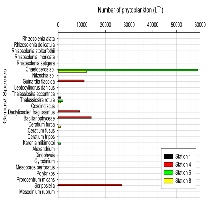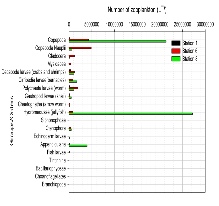University of Southampton Falmouth Field Course 2013 26th June -
4th July 2013 – Estuary Sampling
Falmouth Tides (UTC): HW 02:09 4.20m
LW 09:31 1.50m
HW 15:39 4.30m
LW 22.03 1.5m
Results
Number of zooplankton
Only four groups of zooplankton were counted at Station 1 (Copepoda, Decapoda larvae, Polychaeta larvae and Gastropod larvae). The most common zooplankton counted were Decapoda larvae, with an abundance of 400,000 /L. Station 6 showed a larger range of zooplankton groups present and a change in characteristic zooplankton. Copepoda and Copepoda nauplii were the two most abundant zooplankton groups, with numbers of 4,900,000 /L and 4,300,000 /L respectively. Station 8 shows a further change in characteristic zooplankton, with Hydromedusae becoming the most abundant. Hydromedusae were found with an abundance of 27,200,000 /L and Copepoda with an abundance of 21,400,000 /L. These numbers are much higher than those found at Station 1 and Station 6.
Figure EB.1: Abundance of zooplankton species at each station along the estuary. Station 1 50°14.301N 005°00.927W; Station 6 50° 12.191N 005° 02.430W; Station 8 50° 09. 272N 005° 01.902W.
Number of phytoplankton
One species of phytoplankton was counted at Station 1, the diatom Thalassiosira rotula. The abundance of this species was 1000 cells/L. More species of phytoplankton were counted at Station 4, with Guinardua flaccida, Dactyliosolen fragilissimus, Bacilllariophyceae spp. and Scrippsiella spp. all present. The dinoflagellate Scrippsiella was the most abundant phytoplankton, with an abundance of 27,000 cells/L. There was a drop in species richness from Station 4 and Station 6, however there was an increase in species abundance of the most common phytoplankton species; Chaetoceros spp. which was found with an abundance of 59,000 cells/L, however the diatom Thalassiosira rotula and dinoflagellate Karenia mikimotoi were found at much lower abundances, 2,000 cells/L and 1,000 cells/L respectively. Similarly to Station 8, Chaetoceros was the most abundant phytoplankton species with an abundance of 12,000 cells/L. The diatom Thalassiosira rotula and dinoflagellate Ceratium furca were also found with abundances of 1,000 cells/L each.
Figure EB.2: Abundance of phytoplankton species at each station along the estuary. Station 1 50°14.301N 005°00.927W; Station 4 50° 13.478N 005° 00.934; Station 6 50° 12.191N 005° 02.430W; Station 8 50° 09.272N 005° 01.902W.
Estuary



| Introduction |
| Methods |
| Results |
| Discussion |
| Physical |
| Chemical |
| Biological |
| Physical |
| Chemical |
| Biological |
| Introduction |
| Methods |
| Results |
| Discussion |
| Physical |
| Chemical |
| Biology |
| Physical |
| Chemical |
| Biology |